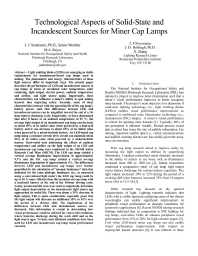Mining Publication: Technological Aspects of Solid-State and Incandescent Sources for Miner Cap Lamps
Original creation date: October 2008
Light emitting diodes (LEDs) are emerging as viable replacements for incandescent-based cap lamps used in mining. The photometric and energy characteristics of these light sources differ in important ways. The present paper describes the performance of LED and incandescent sources in cap lamps in terms of correlated color temperature, color rendering, light output, electric power, ambient temperature and airflow, and light source aging. Importantly, these characteristics can influence the ability of a miner to spot mining hazards thus impacting safety. Secondly, some of these characteristics interact with the operating life of the cap lamp battery power, such that differences between LED and incandescent sources can be magnified toward the end of a 10- hour battery discharge cycle. Empirically, we have determined that after 8 hours at an ambient temperature of 25°C, the average light output of an incandescent cap lamp can decrease to about 69% of its initial value when powered by a lead-acid battery and it can decrease to about 65% of its initial value when powered by a nickel-hydride battery. An LED-based cap lamp using a constant current drive circuit can maintain about 96% of its initial value when powered by a nickel-hydride battery. Real-world tests addressing the effects of ambient temperature and airflow on the light output of an LED and incandescent cap lamp were conducted in the NIOSH Safety Research Coal Mine (SRCM). The LED cap lamp yielded a vertical average illuminance improvement of approximately 9.5% and the INC cap lamp yielded a vertical average illuminance degradation of approximately 4%. The differences between LED and incandescent cap lamps were further quantified by the calculation of mesopic luminance data that indicated for the same photopic luminance (i.e., as measured using a conventional light meter) the LED cap lamp could be up to 38% more efficient than the incandescent cap lamp with a lead-acid battery at the end of the 10-hour driving cycle. Lastly, accelerated life tests were used to empirically determine light output depreciation as the incandescent light source age approached its useful life. There was about a 35% decrease in light output. This is quite considerable, especially given that the light output will decrease an additional 30% to 45% over the period of a 10-hour shift. The implications of the differences between LED and incandescent sources are discussed. This information is crucial in determining how visual performance could be affected for real-world conditions where batteries discharge during the work shift and as the light source ages. To date, only idealized conditions have been used for LED and incandescent cap lamp visual performance research.
Authors: JJ Sammarco, MA Reyes, JP Freyssinier, JD Bullough, X Zhang
Conference Paper - October 2008
NIOSHTIC2 Number: 20034731
IAS '08: Conference Record of the 2008 IEEE Industry Applications Conference: Forty-third IAS Annual Meeting, October 5-9, 2008, Edmonton, Alberta, Canada. Piscataway, NJ: Institute of Electrical and Electronics Engineers, 2008; :1-7
See Also
- Evaluation of Peripheral Visual Performance When Using Incandescent and LED Miner Cap Lamps
- Evaluation of Visual Performance When Using Incandescent, Fluorescent, and LED Machine Lights In Mesopic Conditions
- Illumination
- Mine Illumination: A Historical and Technological Perspective
- NIOSH Illumination Research Addresses Visual Performance Needs with LED Technology
- Technological Aspects of Solid-State and Incandescent Sources for Miner Cap Lamps
- Technology News 556 - The NIOSH LED Cap Lamp Provides Improved Illumination for Greater Safety in Underground Mines
- Underground Coal, Metal, and Nonmetal Mine Illumination Systems for Improving Miner Visual Performance
- Visual Performance for Incandescent and Solid-State Cap Lamps in an Underground Mining Environment
- Visual Performance for Incandescent and Solid-State Cap Lamps in an Underground Mining Environment
- Page last reviewed: 9/21/2012
- Page last updated: 9/21/2012
- Content source: National Institute for Occupational Safety and Health, Mining Program


 ShareCompartir
ShareCompartir
